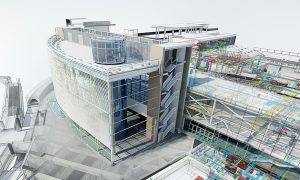Opinion: Walking through a mixed reality future
Jesús Sancho, Middle East managing director, ACCIONA, on how immersive tech is building a future for the construction industry

Many of the problems found in the construction industry are directly correlated with the inability of field personnel, designers, architects and engineers to truly experience a project before it is built. This creates costly issues, and in many instances work has to be stopped or paused as construction teams stumble upon errors which could not be seen on paper. Some other are related to changes during the construction that weren’t projected and are usually hard to identify. Mixed reality covers several technologies that can help prevent many of these situations.
Mixed reality is the merging of real and virtual worlds to produce new environments. It combines the best of both virtual reality and augmented reality. It is an incredible tool that gives professionals in any industry, but particularly in the construction industry, the chance to immerse themselves and interact with the elements of a project as if they were there, even before building has started.
One of the latest technologies we have used is mixed reality, which is set to be one of the mainstream technologies in the near future. It is closely linked with other emerging exponential technologies like for example, the Internet of Things (IoT), 3D printing and machine learning.
It has been proven that taking advantage of each of these immersive technologies – virtual reality, augmented reality and reality capture – delivers better efficiency, productivity and safety for the company. The possibilities are endless!
Virtual reality immerses users in a fully artificial digital environment, allowing interaction with imaginary or real worlds created in a computer. We use this technology to enhance business development, enabling architects and engineers to experiment with different aspects of the design process and decision-making.
It allows them to walk through realistic virtual models of buildings or infrastructures and make all the changes they need, until the design fully matches what they originally had in mind. It is also becoming very important in training, where operators can practise their skills in advance without the need to be present in hostile environments. Immersive and interactive content can be accessed on a large scale from anywhere.
Augmented reality overlays virtual objects on the real-world environment using a smartphone or a tablet. People interact with the real world while digital content is added to it. One of the most powerful applications of this technology is the possibility to view BIM models overlaid onto the existing world, superimposing step-by-step instructions on work stations and visualising hidden services behind walls. It also helps operators to keep facility management software updated.
Another technology used is reality capture applied to construction. This makes possible the digitisation of a wide range of constructions, buildings and facilities. It offers potential business applications such as monitoring of works, BIM models, as-built plans, space planning, process improvement, prevention, virtual tours and facility management.
Reality capture provides numerous benefits for the construction industry, with immersive virtual tours in real environments offering an immersive experience that grants the sensation of being physically present in the captured environment. What’s more, virtual reality can offer us operating applications with measurements, as well as the generation of plans with absolute speed, the planning of reforms, the improvement of processes, the management of spaces and property, and the maintenance of facilities.
Thanks to mixed reality, it is easy to be involved in all project phases to identify potential conflicts or required changes at the design stage, rather than during construction when they can be extremely costly. Construction professionals can ‘walk inside’ their projects and have the ability to spot any fault they would not have been able to identify on their laptops.
The Advanced and Digital Innovation Hub of ACCIONA works with all these technologies to take advantage of them in order to benefit the businesses of ACCIONA. The Mixed Reality Skill Centre is always looking for the latest technology and new applications to facilitate works, allowing us to distance ourselves from our competitors and assume a firm commitment to leadership.





